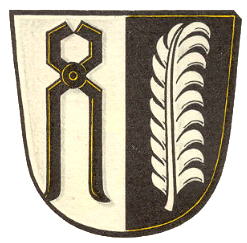Ketternschwalbach: Difference between revisions
Knorrepoes (talk | contribs) m (Text replacement - "/Arms of " to "/Arms (crest) of ") |
Knorrepoes (talk | contribs) m (Text replacement - "{{media}}" to " {{de1}} {{media1}}") |
||
| Line 27: | Line 27: | ||
{{ | |||
{{de1}} | |||
{{media1}} | |||
[[Civic Heraldry Literature - Germany|'''Literature''']]: Hessisches Wappenbuch, 1956 | [[Civic Heraldry Literature - Germany|'''Literature''']]: Hessisches Wappenbuch, 1956 | ||
Revision as of 11:54, 26 December 2022
This page is part of the German heraldry portal Deutsche Wappensammlung |
Heraldry of the World |
|
German heraldry:
|
Selected collector's items from Germany:
|
KETTERNSCHWALBACH
State : Hessen
District (Kreis) : Rheingau-Taunus Kreis (until 1977 Untertaunuskreis)
Incorporated into : 1972 Hünstetten
| German | |
| English | No blazon/translation known. Please click here to send your (heraldic !) blazon or translation |
Origin/meaning
The arms were officially granted on ??-??-19??.
The oldest known seal of the village dates from 1613 and shows a saint holding a plam leaf and a pair of pliers. These are clearly the symbols of St. Agatha, but the church was, as far as known, devoted to St. Paul at the time. Several 18th century seals show different tools, including pliers, whereas on a seal from 1806 the lion of Nassau appears, flanked by two palm leaves. The village was a possession of the Counts of Nassau since 1333.
The arms above show the two attributes of St. Agatha, which also appeared separately on the later seals. As there were no colours known of the seals, the colours were chosen arbitrarily.
Literature: Hessisches Wappenbuch, 1956


